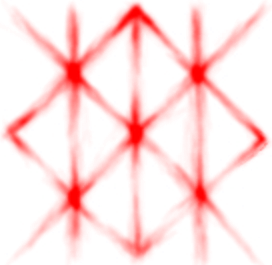26. Complete Stone
The birth of gods and giants, as seen in the top right ascending bar and low right descending bar of Perthro, completes the entire connection of everything with everything. The entire Stone is now sealed with the Gebo rune, which means "Gift" or "Generosity."
The Gift is an exchange, a sign of alliance. Fire gives the gift of Light to Water. Water gives the gift of transparency to Fire. These end-to-end connections make the entire Philosopher's Stone shine, projecting outward.
There is a second shape, complementing Gebo and highlighting the dualistic nature of the stone, the lozenge or 'diamond' shape:
There is no such rune in Elder Futhark, but the symbol itself is very basic, and universal, and has the common meaning of fertility, protection, and balance.
The Ingwaz rune has such a rhombic variant of inscription, and as we already learned in the first chapters, the Ingwaz rune also has such meanings of fertility and balance, so the same meaning is supported by Norse tradition as well.
In our case, we don't consider this shape as a separate entity but only reflect on the holistic symbolism of the entire Philosopher's Stone.
Instead of seeing it as a sequence of specific runes from Elder Futhark, we can see the stone as a three-layer symbol:
- Lozenge - the border, preservation, reproduction.
- Gebo - connection, influence, expansion.
- Three vertical lines - three phases, order, structure, purpose, and plan.
Another way to compose Philosopher's Stone is to scratch the surface with three claws three times:
So not only human, but also a wild beast can approach the source of Creation.
